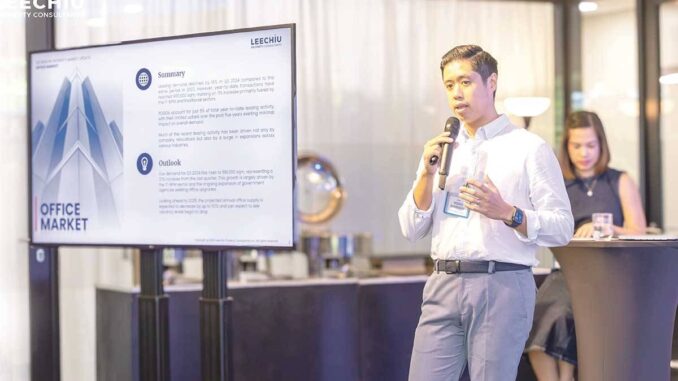
DEMAND for office spaces by the IT-BPM (information technology-business process management) sector and government agencies rose steadily in the third quarter of 2024.
Meanwhile, the units leased to Philippine offshore gaming operators (POGOs) experienced a significant drop due to their banning by President Ferdinand Marcos Jr. a few months ago.
These are the trends noted by professional real estate brokerage company Leechiu Property Consultants (LPC) in its recent media briefing about its Q3 2024 Philippine Property Market Report.
LPC director of commercial leasing Mikko Barranda. PHOTO FROM LPC
According to the report, office demand dropped to 215,000 square meters (sqm) in Q3 2024, experiencing a decrease of 16 percent compared to the same period last year. However, the year-to-date (YTD) demand for office space has reached 900,000 sqm, marking an 11 percent increase over the first three quarters of 2023.
In previous quarters, tenants typically moved laterally to higher-quality buildings while maintaining similar space requirements. However, one tangible shift has seen them opting for both better and larger spaces. A significant portion of YTD office leasing activity comes from existing tenants expanding their office spaces, particularly in buildings that are 5 to 10 years old.
The IT-BPM industry and traditional office sectors were key drivers of this momentum. The former accounts for 55 percent (or 319,000 sqm) of the ongoing live demand, which increased by 27 percent (from 457,000 sqm to 581,000 sqm) in Q3 2004. Traditional office tenants make up the remaining 45 percent. In Metro Manila, Makati and Bonifacio Global City (BGC) are the top choices for office space, while outside the metro, Davao, Cebu and Batangas are the prime locations for office leasing.
Government agencies also played a substantial role, contributing 119,000 sqm of space demand.
Mikko Barranda, LPC director of commercial leasing, attributed this ongoing expansion to several reasons. First, many of the agencies finally seek to own their buildings and spaces instead of renovating the current ones that they had been occupying for years, if not decades. The second is a matter of efficiency: “Some are eager to consolidate, like those with different buildings scattered in one district and who are not able to capitalize on their entire space.” Consolidation can “link their workforce and maximize their agency footprint.”
Additionally, aside from the expansion of offices of IT-BPM companies, new firms from the US and other nations have come in to explore offshoring opportunities in the Philippines. These new entrants make up 12 percent of IT-BPM demand, indicating that the country remains an attractive location for foreign businesses.
Metro Manila continues to lead in-office transactions, with the Bay Area taking the lead in market share of office demand in the capital, driven primarily by government agencies occupying 80,000 sqm in the first nine months of the year. Outside the capital, Cebu remains the dominant provincial market, supported by demand from the IT-BPM sector.
Meanwhile, the POGO industry continues to downsize, contributing to the increase in vacated office space. It currently accounts for just 8 percent of YTD leasing activity, a huge drop from its pre-Covid transactions when it comprised a huge 45 percent of total leasing demand.
Barranda said that the “sharp growth” in live demand “indicates a significant surge in market activity and interest, reinforcing our confidence in a strong finish for the year. The momentum we’re witnessing also offers an encouraging preview of 2025, as we anticipate continued demand and steady growth in the market.”


Be the first to comment